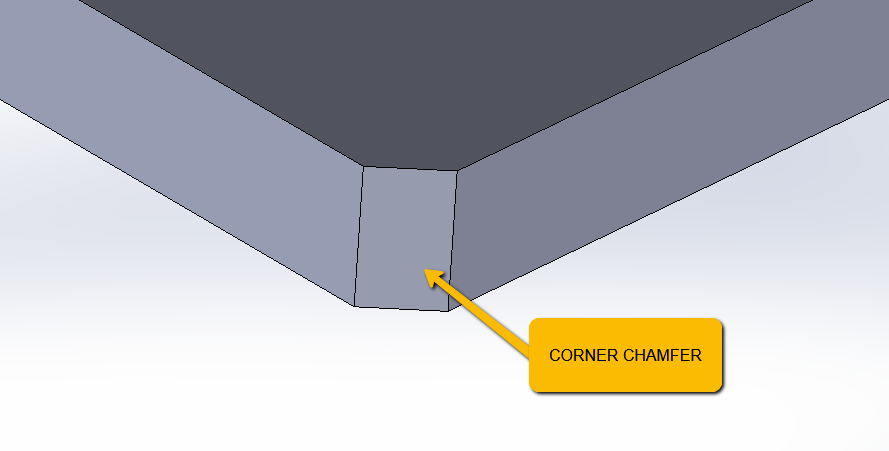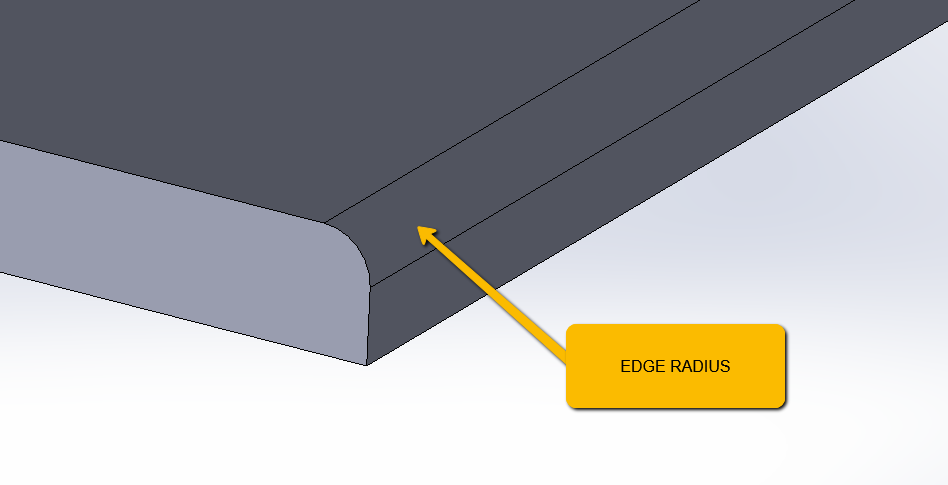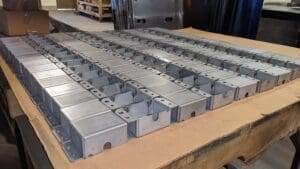Last updated on January 6th, 2025 at 11:15 am
Chamfers and radii are commonly requested features in custom sheet metal fabrication that can occasionally cause confusion.
Whether your sheet metal parts need the angled edge of a chamfer or the rounded edge of a radius, there are a few things you should know.
Table of Contents
- 1 Chamfers and Radii: What’s the Difference?
- 2 The Secret to Safe Edges and Easy Assembly
- 3 How to Get Chamfers and Radii with Critical Dimensions
- 4 Get Sheet Metal Parts with Chamfers, Radii, or Simply Safe Edges at ASM
- 5 Sheet Metal Fabrication Chamfers & Radii FAQ
- 5.0.1 What is the difference between a chamfer and a radius?
- 5.0.2 How does ASM achieve chamfers and radii on sheet metal parts?
- 5.0.3 Should I dimension chamfers and radii on my print or model?
- 5.0.4 What should I do if safety is my main concern for my sheet metal parts?
- 5.0.5 How can I communicate my requirements for chamfers and radii effectively?
Chamfers and Radii: What’s the Difference?
Adding chamfers or radii to a part’s edges is a smart way to improve fit, eliminate unsafe edges, and enhance the part’s aesthetic appeal. So, what’s the difference between the two features?
- Chamfers. A chamfer is a 45-degree bevel cut across adjoining right angles. Chamfers are often used to create clearance for mating or connecting parts. We often add chamfers to brackets, enclosures, and faceplates. Chamfers can also simplify the task of manually positioning parts during assembly, and they prevent injury by eliminating sharp edges. (Technically speaking, only corners cut to 45 degrees are called chamfers, though the terms “bevel” and “chamfer” are often used interchangeably.)
- Radii. A radius replaces a raw corner with a rounded edge rather than a chamfered edge. Engineers typically design radii to improve a part’s safety and enhance its appearance, though, like chamfers, radii can also improve the assembly and fit of mating or connecting parts.
Achieving chamfers and radii
ASM can achieve chamfers and radii using various methods, such as special punch tools, hand-filing, or shaping with a dual-action sander. Tumbling can be an effective way of adding a radius to your part’s edges. For chamfered and rounded edges with critical tolerances, however, machining is almost always the best—and only—solution.
More on that in a minute.
The Secret to Safe Edges and Easy Assembly
When enhanced safety and simplified assembly are important for your sheet metal parts, either chamfers or radii will do the trick. You don’t even need to dimension these features on your print or include them on your model. In fact, don’t dimension your edges—or we’ll quote you for critical dimensions you don’t actually need!
You can further your savings by removing the non-critical chamfers and radii from your 3D model, too. If you don’t do it, we will have to remove these design elements prior to programming our machines.
Safety, simplified
If your sole goal is safety, the simplest way to get your part’s sharp edges removed is to ask. Just add a note to your print asking us to “remove all sharp edges”—and we will.
At ASM, deburring is included as part of our standard processes, so if safety is your only focus, deburred metal edges are usually considered sufficiently smooth.
How to Get Chamfers and Radii with Critical Dimensions
When we see that you’ve dimensioned the chamfers and radii on your print, we trust that those dimensions are critical and that you’ll inspect your parts in accordance with those dimensions.
To ensure precision and accuracy, we’ll engage our CNC machine shop to machine the chamfers or radii. Though machining does add to a part’s cost and lead time, it’s the best process for achieving critical edge specifications and preventing part rejections during inspection.
Additional Considerations
- Design Intent and Functionality: The choice between chamfers and radii should align with the part's intended function. Chamfers are often used to facilitate assembly by guiding components into place, while radii can reduce stress concentrations, enhancing the part's structural integrity. Understanding the specific functional requirements can guide the appropriate application of these features.
- Manufacturing Constraints: The feasibility of incorporating chamfers or radii depends on the manufacturing process. Chamfers typically require machining, which can increase production time and cost. In contrast, radii can often be achieved through standard sheet metal fabrication techniques, such as bending or stamping, making them more cost-effective in certain scenarios.
- Material Considerations: Different materials respond uniquely to chamfering and radiusing. For instance, materials with higher hardness may require specialized tooling to achieve the desired edge treatment, impacting both the process and cost.
- Tolerance Specifications: When specifying chamfers and radii, it's crucial to consider the achievable tolerances. Tighter tolerances may necessitate precision machining, affecting lead times and costs. Clearly communicating the criticality of these tolerances can help in selecting the most appropriate manufacturing method.
- Aesthetic and Ergonomic Factors: Beyond functionality, chamfers and radii contribute to the visual appeal and safety of the part. Rounded edges (radii) are often preferred in consumer-facing products for a smoother appearance and safer handling, while chamfers can convey a more mechanical or precise aesthetic.
- Impact on Assembly: The presence of chamfers or radii can influence assembly processes. Chamfered edges can act as lead-ins for mating parts, simplifying alignment and assembly. Radii can prevent snagging or catching during assembly, promoting smoother operations.
- Stress Distribution: Radii are particularly effective in distributing stress over a broader area, reducing the likelihood of stress fractures. Chamfers, while useful for assembly, may create stress concentration points if not properly designed.
- Cost Implications: Incorporating chamfers generally involves additional machining steps, potentially increasing costs. Radii, depending on the required size and precision, might be achievable through less costly processes like stamping or bending. Balancing design requirements with budget constraints is essential.
- Standardization and Consistency: Maintaining consistent chamfer and radius dimensions across different parts can simplify manufacturing and inspection processes, leading to cost savings and improved quality control.
- Post-Processing Effects: Consider how subsequent processes, such as coating or painting, might affect or be affected by chamfered or radiused edges. For example, coatings may accumulate differently on sharp edges compared to rounded ones, impacting both appearance and durability.
Get Sheet Metal Parts with Chamfers, Radii, or Simply Safe Edges at ASM
The number one way to get sheet metal parts made your way is to use your print, model, and RFQ to communicate clear specifications and expectations. When we thoroughly understand your goals and requirements, we’re empowered to not only achieve them but also recommend alternative solutions when we identify a better approach.
Talk to our team about your next custom sheet metal fabrication project. Get started by requesting a quote, and we’ll be in touch with you soon!








